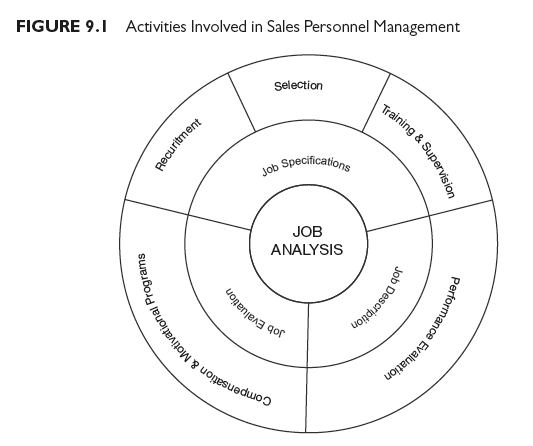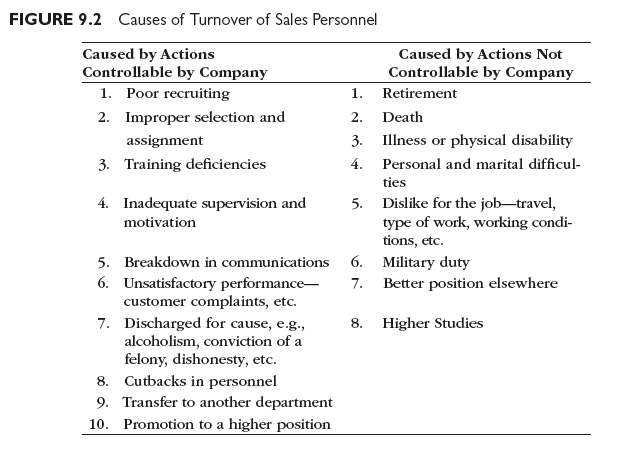Sales force management is a specialized type of personnel management. It is not possible to exercise close and constant supervision over sales personnel—at least not in the sense that one can supervise production and office workers. Furthermore, sales personnel work away from their coworkers and immediate superiors, so it is difficult to develop a spirit of identity with and loyalty to the company and to weld them into a unified team.
Sales persons are relied upon as individuals to plan and control their own activities. Most sales personnel visit the company’s office infrequently, and centralized direction of their activities is mainly by phone, email and sales force automation software.
Other unique conditions surround the selling job. Often the salesperson is away from home and family for extended periods. Selling success (or failure) depends upon prospects’ and customers’ actions and reactions; disheartening order turndowns and rebuffs from customers require the salesperson to repress normal responses and to suppress a natural tendency to become discouraged. The psychological effects of these conditions accentuate the need for sales management to pay continual attention to motivational factors.
The steps in sales force management are the same as those in general personnel management. Sales force management work, as shown in Figure 9.1, starts with job analysis—determining the job objectives, the component duties and responsibilities, performance criteria, and reporting relationships. The output of job analysis is the written job description that is used in deriving the necessary qualifications (job specifications) of the employee. Qualified job applicants must be found, and this requires decisions on recruiting sources and methods. From the supply of applicants, those meeting the job specifications are selected. After hiring, applicants undergo initial training and throughout their entire careers with the company—receive continuing training through diverse delivery systems. Compensation plans are designed to provide appropriate levels and methods of compensation.
When the salesperson is assigned to the field, other personnel activities come into play. The salesperson is motivated to plan and make productive use of working time. To improve the effectiveness of sales calls, salespersons are counseled on working habits and methods. Controlling sales personnel requires analysis of selling records and evaluations of sales performance.
Sales force management activities mesh into a system. Faulty execution of any activity results in complications for other activities. If recruiting and selecting are sloppy, training tasks are magnified, supervision problems become greater, motivating and controlling salespersons is more difficult, and the turnover of sales personnel is accelerated. If training is inadequate, potentially good people fail to reach high productivity, the compensation system does not work as planned, supervision is ineffective, and there is excessive personnel turnover. Similar “bundles” of difficulty arise in cases of ineffective performance of other activities in the sales force management system.

1. Economies of Effective Sales Force Management
There are economies in effective sales force management. Assume that company X has ten salespersons, each making five calls per day, a total of fifty per day for the company. Assume further that four calls out of five result in sales and that the average sale amounts to $500. If through more effective management, each salesperson increases the number of calls to six per day, the company’s daily total becomes sixty (an increase of ten), and eight more sales per day are made (8 X $500 = $4,000). This is equivalent to adding two new salespeople at the old call rate. If sales personnel are paid wholly, or partially, on a commission basis, their incomes are now higher and morale should be improved. Furthermore, because some selling costs
are related to the number of salespeople, the company’s average cost per call should be reduced. There are two types of expenses of maintaining a sales force: fixed and variable. The fixed expenses are identical for all sales personnel regardless of their productivity, while the variable expenses are highest for the least productive sales personnel. Fixed expenses include sales salaries, traveling, equipment (autos, sales folios, sales manuals, and so forth), and advertising used to assist the sales force. Variable expenses include sales commissions, training, motivating, supervising, and con- trolling—these expenses are lower per unit of product sold for productive salespersons than for unproductive salespersons. In other words, when a company incurs variable expenses for maintaining its sales force, it receives its highest return from the most productive sales personnel. Total expenses per unit of product sold vary inversely with the productivity of the salesperson.
2. Rate of Sales Personnel Turnover
The rate of sales personnel turnover is a measure of the quality of sales force management. This is the ratio of separations per 100 salespeople. For example, a company employing a sales force of 250 persons and having twenty separations during the year has a rate of turnover of 8 percent.[1]
The turnover rate influences the total expenses of sales force management. Costs of recruiting, advertising, fees to employment agencies, and so forth often run to more than $500 per recruit. Interviewing costs are high, because companies interview several applicants for each selection. If an interview by an executive takes two hours, an executive’s time is worth $25 per hour, and thirty people are considered for each vacancy, total interviewing costs amount to $1,500 per person hired. The costs of travel and time used for preparatory and follow-up training easily run $10,000 per person.
Some expenses are not readily calculated. For example, new recruits do not produce as much as experienced sales personnel, and the ratio of selling expenses to sales for a new person is likely to be excessive for at least the first year. A conservative estimate of the excess is $3,500 per new salesperson during the first year, and in some companies this excess is higher because it takes longer for a salesperson to get fully into stride.
The expenses of sales personnel turnover can account for a significant drain on profits. In a company with a sales force of 400 and an annual turn-over rate of 25 percent, if the costs of replacing a single salesperson come to $ 10,000, the annual costs of turnover total $1 million—and this is only out-of-pocket cost. Other costs are increased expenses for supervision and motivation, lost business, decline in customer goodwill from mistakes of inexperienced salespersons, and miscellaneous expenses associated with taking on people who do not succeed. Few accounting systems measure the impact on profit of excessive sales personnel turnover. But profits are lower because inexperienced salespeople are assigned where turnover has occurred. Profits are not realized from sales not consummated.
All turnover is not bad, even though it seems costly. Sales executives report that most salespeople who leave a company have less than three years of service. If a person is proving unsuccessful, and is likely to leave eventually, it is desirable that the person leave immediately. The earlier the unsuccessful person leaves, the better off the company is, both in terms of dollar costs and effect upon other sales personnel. Too low a rate of turnover may indicate that the sales force is overloaded with veterans who do not produce as much as new personnel might. In this situation the entire system of sales force management may need overhauling. Some turnover is desirable. A sales force with no turnover may be growing stale, prospective new salespeople are not being attracted, and older ones are lingering on because of management laxity.
The age distribution among sales personnel should be analyzed for its impact on sales force turnover. It is desirable to spread salespersons’ ages over a wide range. Otherwise, the productivity curves for all rise together, all reaching their peaks and declining together, and all reaching retirement at the same time.
Under these circumstances, it is necessary eventually to recruit an entire sales force almost at once, at considerable loss in market coverage and customer relations. Companies should establish an average length of service, which management considers desirable, before evaluating the turnover rate. If management believes the average length of service should be twenty years, then, assuming no errors in selection, the personnel turnover rate should be 5 percent—one-twentieth of the sales force should be replaced each year. Because even the best selection procedure is far from perfect, the actual turnover rate would run higher than 5 percent. In addition, many people do not take sales jobs with the intention of keeping them forever. A sales job is often the springboard to higher positions, and a company using its sales force as a source of managerial talent anticipates higher turnover.
Awareness of the current turnover rate is necessary for planning the operation of service functions. The personnel turnover rate is important in creating a plan for recruiting, selection, and training programs. For example, a company with a turnover rate of 25 percent is replacing its sales force every four years. It must organize its service functions to handle an annual volume of new recruits equivalent to one-fourth of its sales force. The costs and extent of the recruitment, selection, and training programs largely depend upon the amount of turnover.
The personnel turnover rate is analyzed periodically to determine the causes. Analysis often uncovers areas where improvement is needed. A useful information source is an exit interview between the departing salesperson and either a line executive or a personnel consultant. This interview provides an opportunity to identify conditions contributing to personnel turnover. Identification enables management to modify or correct conditions within its control.

Causes of personnel turnover can be separated into two main groupings, as shown in Figure 9.2. Management should take corrective action when the causes are concentrated on the controllable list, particularly when turnover traces to reasons 1 through 7. Turnover resulting from reason 8 sometimes is unavoidable, and that resulting from 9 and 10 is usually desirable. Managerial action may be called for, even in the cases of some reasons appearing on the “not controllable” list; in fact, only reasons 2, 3, and 6 may be regarded as completely unavoidable.
Source: Richard R. Still, Edward W. Cundliff, Normal A. P Govoni, Sandeep Puri (2017), Sales and Distribution Management: Decisions, Strategies, and Cases, Pearson; Sixth edition.

Hiya very nice site!! Guy .. Beautiful .. Amazing .. I’ll bookmark your site and take the feeds alsoKI’m glad to search out so many helpful info right here within the publish, we want work out extra strategies in this regard, thanks for sharing. . . . . .